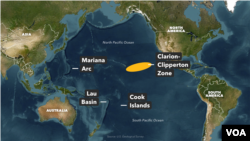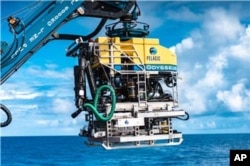When activists, policymakers and representatives from across the globe gather next week in New York to participate in climate week, one pressing issue on the agenda that is less frequently discussed and known will be the environmental impact of seabed mining.
As countries look for ways to lower emissions, critical minerals are playing a key role in that transition. Critical minerals are used in all kinds of green technologies, from solar panels and wind turbines to batteries in electric vehicles. And one place where those mineral resources are abundant is deep under the sea.
The debate over accessing seabed resources is heated. Supporters say the technology exists to safely access these critical minerals undersea, but environmentalists and activists say the potential of undiscovered biodiversity on the seafloor is too important to endanger.
During climate week, which will take place on the sidelines of U.N. General Assembly meetings, organizers are expected to host a roundtable on the environmental impact of seabed mining and other discussions about critical minerals.
The World Economic Forum says that if the globe wants to reach net-zero emissions by 2050, two-thirds of vehicles must be powered by electric batteries. And the International Energy Agency says that to reach that goal, the world needs six times more mineral resources by 2040 than it has today.
Some of the largest mineral deposits are found on the ocean floor in the form of polymetallic nodules, or rocks.
Ocean of resources
According to the International Seabed Authority, or ISA, there are 21 billion tons of polymetallic nodules strewn across the seabed of the Clarion-Clipperton Zone, or CCZ. Each nodule contains a combination of electric vehicle battery components such as nickel, manganese, copper and cobalt. The ISA plans to release regulations for mining in the international waters of the CCZ by 2025.
The ISA has already awarded 17 exploration contracts for polymetallic nodules in the Clarion-Clipperton Zone – a large swath of the Pacific Ocean the size of the continental United States which sits between Hawaii and Mexico. Three of those exploration contracts went to The Metals Company, a Canadian deep-sea mining company.
The Pacific Island Nations of Nauru, Kiribati and Tonga have sponsored The Metals Company’s efforts to develop a portion of the seabed. In an interview with VOA, CEO Gerard Barron said the company is ready to begin as soon as the ISA allows mining.
“Our collector methodology is to put a robot on the seafloor which crawls around the ocean floor and fires a jet of water at the nodule and it creates an inverse pressure and lifts the nodule up, and so we don’t go down and scour the seafloor,” said Barron via Zoom, adding that TMC has spent the past decade focused on testing this equipment and collecting data on its environmental impact as part of its permit application to the ISA.
Moratorium needed
Critics worry scooping up these mineral-rich rocks will disrupt important biodiversity – much of it still unnamed and some of it undiscovered. Researchers have found that 90% of the more than 5,000 species in the zone are new to science. Eddie Palu, president of the Tonga Fishery Association, wants a pause for more research.
“We demand a moratorium on the seabed mining until the environmental, economic and social risk are comprehensively understood,” he said during a panel discussion at the recent Pacific Islands Forum in Tonga.
Shiva Gounden from Greenpeace Australia Pacific, who also sat on the panel, agreed.
“We know only very little of the deep sea, and the race for the final frontier could cause irreversible damages to the people and to the communities of our Pacific,” Gounden said.
But scientists say no light and very little oxygen reaches the deep sea – limiting the life there to mostly bacteria and small invertebrates.
The Metals Company’s Barron said combating climate change is a bigger threat to the planet than undersea mining, adding that the company’s environmental impact studies show that “we can safely collect these nodules” and turn them into battery metals without having “a negative impact on the ocean.”
“The notion that we can do any extraction with zero impact is a dream,” added Barron. “The oceans are impacted by every single thing we do today, especially global warming. So, we need to address the main driver for climate change and reduce emissions.”
Fueling innovation
Still, the quest to do just that – access minerals on the seabed with minimal impact to the environment – has created competition between technology companies.
U.S. tech startup Impossible Metals is testing a robot which can avoid nodules where it detects life and harvests those where it does not.
“The vehicle hovers above the seabed, uses the camera and it actually picks up the nodules one by one. So this really minimizes all of the negative concerns around big sediment plumes,” CEO Oliver Gunasekra told VOA in an interview.
Gunaskera’s company spun off Viridian Biometals. Its technology bypasses energy-intensive processes such as smelting with bacteria which can separate metal ore from the rock around it. The process creates no emissions or waste.
“The bacteria need oxygen just like we do to breathe. And when there's not enough oxygen in the water around them, the bacteria have learned that there's oxygen in the rocks, and they have adapted to breathe that oxygen,” said Viridian CEO Eric Macris.
Impossible Metals and Viridian Biometals say they are two to three years out from commercializing their technology, depending on funding. TMC says it could be ready to begin its collection operations as soon as international regulations are released next year.



